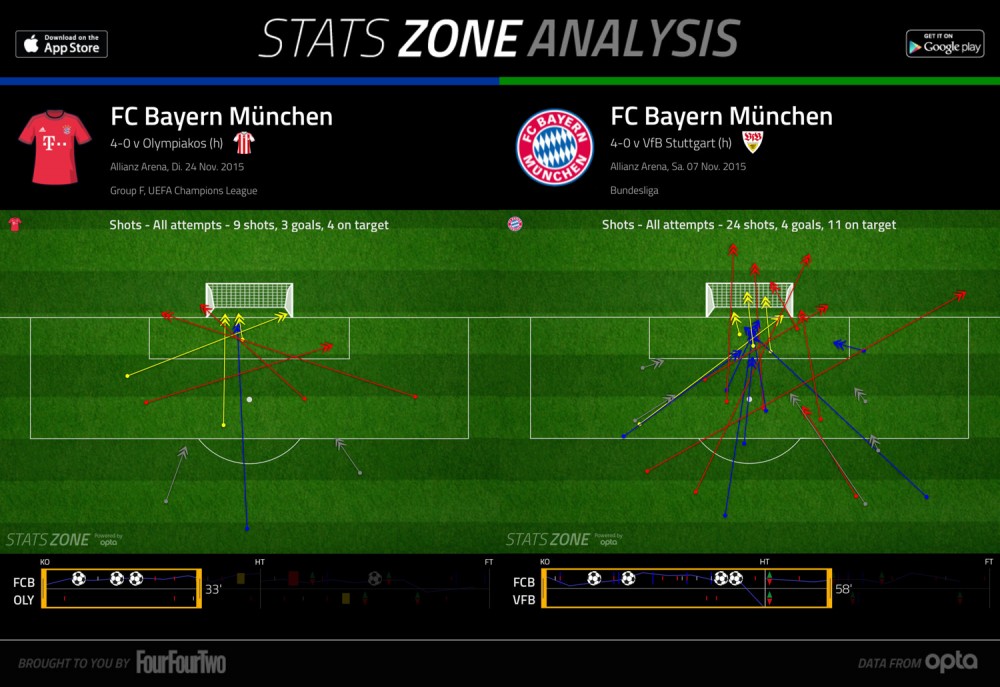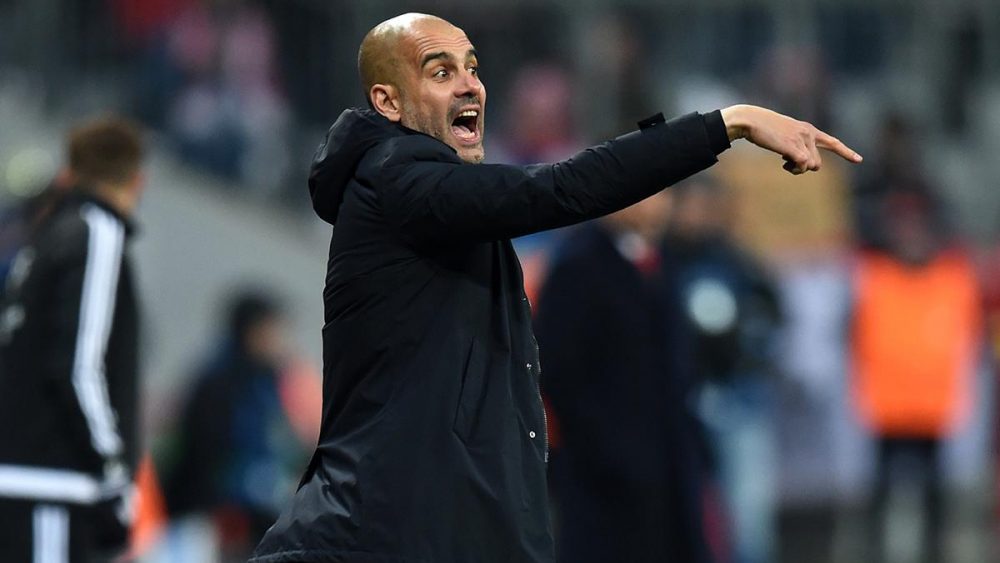Guardiola’s Lineup of Death
The Golden State Warriors are the reigning champions of the American basketball league NBA and something like the prototype of modern basketball. The team from California is currently hyped because of their starting record. The team – led by superstar Stephen Curry – has won 16 consecutive games.
[Editor’s note: the original article was published on Nov 26th; the Warriors streak is still alive after 20 games]
The Warriors have connected many tactical trends in basketball and have driven their approach to the extreme in recent months: a fast, fluid positional game with high scoring efficiency. A particularly innovative feature is playing the only 6 feet 7 inches (201 cm) tall Draymond Green at the center position, which would otherwise be occupied by much larger and slower types of players. The Warriors are lined up considerably smaller than their opponents, but hard to defend due to their speed advantages. “Lineup of Death” or “Nuclear lineup” are current nicknames they have received due to their outstanding statistical superiority. More important than the height, however, is the fact that the Warriors have five real playmakers on the floor simultaneously. Players that are able to dribble, shoot, pass and defend at a high level. Allrounders with certain special abilities, instead of specialists with many deficits.
A goal scored every 15 minutes
The connection to football and Bayern Munich may seem a bit forced, but Pep Guardiola has perhaps found something like his own “lineup of death” in the past few weeks. In three of the last four home games Guardiola put all of Douglas Costa, Coman, Robben, Müller and Lewandowski – five nominal strikers – on the pitch. The result so far has been outstanding.

Against Cologne, Stuttgart and Olympiacos, this formation collected a total of 157 minutes together on the field and created a goal difference of 10-0, scoring a goal every 15 minutes on average. Bayern logged 52 shots on goal in these minutes. That’s almost 30 shots per 90 minutes and thus nearly 10 shots more than their season average. Nine of the ten goals were scored between these five players. This quintet even dished out four assists additionally. Five of the 10 goals were scored in the first 20 minutes of each game – a very important factor for Bayern’s game.
Guardiola’s ideas are clear. He weakens the central midfield, because he knows that their build-up game can be delegated to his holding midfielder and his back-four against deep-sitting opponents without taking any risks. Thus he doesn’t need a specialized number 8 or 10, because the other six players are capable of constructively and quickly playing the ball in the second and final third. Furthermore, the counter pressing worked well against those opponents, so that the potential open spaces around the central midfielders could hardly be used by their opponents. Thiago’s injury has arrived as an additional argument for this lineup.
A quintet that’s hard to stop
Unquestionably the combined playing time of 157 minutes is rather small and neither Stuttgart nor Olympiacos are necessarily a paragon of an established defensive organization. Nevertheless, Guardiola is well advised to continue thinking in this direction. In the past, some teams have managed to disturb Munich’s dribbling-based wing play by overloading and compressing one side of the pitch. Very good teams have sometimes even succeeded against both wings, if their defense is able to move quickly from side to side. Against three strong dribblers (Costa, Coman, Robben), two on the wings and one in the half-spaces, plus two excellent complementary players who offer good positioning and movement in the box (Lewandowski, Müller), the opponent’s task is much more difficult.
It’s almost impossible to prevent one-on-one situations or being outnumbered along the entire horizontal line at the edge of the box at any given time, especially when Bayern so accurately shift the ball to the far wing out of the defense with a diagonal ball like in their last games against Cologne, Stuttgart and Olympiacos. The opponents seemed to be both individually and collectively overwhelmed in phases of the game.
Even if the goals against Olympiacos were a little bit lucky, the systematic advantage of the high positioning of the quintet was visible nonetheless. During Boateng’s long range shot before the 1-0, all five offensive players were lined up like pearls on a string at the edge of the box waiting for the rebound, which Costa ultimately reached with his speed. Costa, Lewandowski and Müller were all in the penalty area and thus managed to create a 3v3 situation centrally in front of the goal. For the 2-0, Coman fired a shot from 25 meters away and had four teammates between himself and the goal – the ball ended up somewhat luckily with Lewandowski, who only had to tap in. For the 3-0 as well, all five offensive players went for a cross from Lahm inside the penalty area, thus creating a 5v3 situation in the six-yard-box. Via Coman and Robben, the ball ended up at Müller’s feet. The agility and presence of the five players around and inside the box created many problems for the opposing defensive near their goal, just like in the previous matches. Shots and goals are only a logical result.
And somehow in the past weeks the quintet has resembled, in fact, the Golden State Warriors in the NBA. Five playmakers played alongside each other in offense, always able to create opportunities for each other and force the defensive line to react. Either by dribbling, quick one-twos, a cross or a quick shot. Neither team has stopped that sustainably this season. The term playmaker is different from the term “Spielmacher” in football. The playmaker is less focused on steering the game and rather tries to create shots for himself and teammates and to put the opponent’s defense under pressure. Xabi Alonso is a “Spielmacher”. Douglas Costa and Arjen Robben are rather playmakers in this definition.
Abandoning specialists in favor of all-rounders is incidentally another identifiable similarity. The tall center in basketball might in football be a strong number 9 with good heading abilities in the penalty area. The pass-oriented point guard resembles the strategic-minded but not shot-focused number 10 in football. Guardiola has a history of doing without these two types of players that have previously dominated football.
Guardiola initially replaced the two number 6s and the number 10 that he inherited from Heynckes with a single number 6 and two number 8s (changing from 4-2-3-1 to 4-3-3/4-1-4-1). This season, it has often been only a single number 6 and a number 8, or in his last games even only one central midfielder behind a variable attacking quintet with a striker in the most central role who can pass and dribble.
More chances to prove themselves?
Of course, this formation also carries weaknesses – especially in the transitional defense. Therefore, Guardiola refrained from fielding the quintet together in the last away games. Guardiola will use the coming weeks without Thiago to balance things out. Especially the formation to be used in the away match against the “feared foals” from Mönchengladbach is eagerly awaited. It is a tempting idea to see Munich’s quintet line up against the best teams in Europe in the second half of the season, with the further option to have Franck Ribery as another puzzle piece. But there is still a long way ahead.
Nevertheless, one thing holds true for both the Golden State Warriors and Bayern Munich: the defense which can sustainably take on the “lineup of death” has not yet been found.




 December 3, 2015
December 3, 2015 


